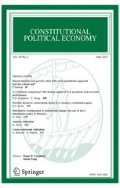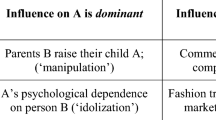Abstract
This paper is about the use of the homo economicus behavioral model in the constitutional political economy research program. The paper argues that all existing arguments in defense of the behavioral model fail. These arguments are: the symmetry argument, the enterprise argument, the increasing costs argument, and the crowding out argument. As a result, those working in the constitutional political economy tradition are not justified in employing homo economicus, at least not until a new argument successfully defending the behavioral model is provided.
Similar content being viewed by others
Notes
On this point see Brennan and Hamlin (1995: 289).
For explicit endorsement of the narrow wealth-maximizing version of homo economicus for employment in CPE see Brennan and Buchanan (1980/2000: 19); Brennan and Buchanan (1981: 156, 159); Brennan and Buchanan (1983: 89–90); Brennan and Buchanan (1985/2000: 53); Buchanan (1990/1999: 392). It is not, of course, a necessary feature of CPE that narrow homo economicus be employed. For instance, Brennan and Hamlin (1995: 298–301) argue that CPE (not public choice theory) should apply a much wider utility function than simple wealth-maximization. That said, the founder of CPE and several followers believe that the narrow version of homo economicus ought to be applied to the endeavor of constitutional comparison and constitutional choice. This paper focuses on this understanding of CPE.
In what follows I no longer distinguish between narrow and wide homo economicus. The arguments presented are in defense of employing narrow homo economicus and I analyze them in terms of whether they can in fact justify the employment of narrow homo economicus. From this point forward my use of the term homo economicus signifies the narrow version of homo economicus.
See Buchanan and Tullock (1962/2004: 19).
I thank the editor of Constitutional Political Economy for this insightful remark.
One might think that this objection is falsified by Becker (1981/1993)’s impressive work on the economics of the family. However, though Becker certainly applies the rational choice behavioral model to the study of the family, he does not apply narrow homo economicus in particular. He defines utility functions such that members of the family maximize things besides wealth.
Hume (2000: 313) says: “So far from thinking, that men have no affection for any thing beyond themselves, I am of opinion, that tho’ it be rare to meet with one, who loves any single person better than himself; yet ‘tis as rare to meet with one, in who all the kind affections, taken together, do not over-balance all the selfish. Consult common experience: Do you not see, that tho’ the whole expence of the family be generally under the direction of the master of it, yet there are few that not bestow the largest part of their fortunes on the pleasures of their wives, and the education of their children, reserving the smallest portion for their own proper use and entertainment?” (emphasis mine).
Stigler and Becker (1977).
Brennan and Buchanan (1981: 160) emphasis mine.
On this point see Boettke and Leeson (2004: 107).
Brennan and Buchanan (1985/2000: 60).
In his explication of the circumstances of justice Rawls (1971/1999: 206) insists that, though in the circumstances of justice there is by definition conflict of interests, such conflict “can obtain under the most varied circumstances and from any number of motives.”
Throughout this section my model assumes that all welfare losses are spread equally across all 50 members of our society.
The two authors admit as much at Brennan and Buchanan (1983: 103).
Brennan and Buchanan (1985/2000: 68).
Buchanan (1965/1999).
As Axelrod (1984)’s seminal work shows, when playing iterated games a tit-for-tat strategy yields the highest sum payoff when played against a diverse panel of other strategies.
References
Axelrod, R. (1984). The evolution of cooperation. New York: Basic Books.
Becker, G. (1981/1993). A treatise on the family. Cambridge: Harvard University Press.
Boettke, P. J., & Leeson, P. T. (2004). Liberalism, socialism, and robust political economy. Journal of Markets & Morality, 7, 99–111.
Brennan, G., & Buchanan, J. M. (1980/2000). The power to tax: Analytical foundations of a fiscal constitution. Indianapolis: Liberty Fund.
Brennan, G., & Buchanan, J. M. (1981). The normative purpose of economic ‘Science’: Rediscovery of an eighteenth century method. International Review of Law and Economics, pp 155–166.
Brennan, G., & Buchanan, J. M. (1983). Predictive power and the choice among regimes. The Economic Journal, 93, 89–105.
Brennan, G., & Buchanan, J. M. (1985/2000). The reason of rules: Constitutional political economy. Indianapolis: Liberty Fund.
Brennan, G., & Hamlin, A. (1995). Constitutional political economy: The political philosophy of homo economicus? The Journal of Political Philosophy, 3, 280–303.
Buchanan, J. M. (1965/1999). Ethical rules, expected values, and large numbers. In: G. Brennan, H. Kliemt, R. D. Tollison (Eds.). The collected works of James M. Buchanan: The logical foundations of constitutional liberty (pp. 311–328). Indianapolis: Liberty Fund.
Buchanan, J. M. (1990/1999). The domain of constitutional economics. In: G. Brennan, H. Kliemt, R. D. Tollison (Eds.), The collected works of James M. Buchanan: The logical foundations of constitutional liberty (pp. 377–395). Indianapolis: Liberty Fund.
Buchanan, J. M., & Tullock, G. (1962/2004). The calculus of consent: The logical foundations of constitutional democracy. Indianapolis: Liberty Fund.
Congleton, R. D. (2014). The contractarian constitutional political economy of james buchanan. Constitutional Political Economy, 25, 39–67.
Hume, D. (2000). In: D. F. Norton, M. J. Norton (Eds.), A treatise of human nature. Oxford: Oxford University Press.
Kirchgässner, G. (2014). The role of homo oeconomicus in the political economy of James Buchanan. Constitutional Political Economy, 25, 2–17.
Rawls, J. (1971/1999). Justice as reciprocity. In: S. Freeman (Eds.), John Rawls: Collected papers (pp 190–224). Cambridge: Harvard University Press.
Stigler, G. J., & Becker, G. S. (1977). De gustibus non est disputandum. The American Economic Review, 67, 76–90.
Tullock, G. (1959/2004). Problems of majority voting. In: C. K. Rowley (Eds.), Virginia political economy. (pp. 51–68). Indianapolis: Liberty Fund.
Vanberg, V. J. (2014). James M. Buchanan’s contractarianism and modern liberalism. Constitutional Political Economy, 25, 18–38.
Author information
Authors and Affiliations
Corresponding author
Rights and permissions
About this article
Cite this article
Kogelmann, B. Modeling the individual for constitutional choice. Const Polit Econ 26, 455–474 (2015). https://doi.org/10.1007/s10602-015-9197-z
Published:
Issue Date:
DOI: https://doi.org/10.1007/s10602-015-9197-z
Keywords
- Constitutional political economy
- Constitutional choice
- Homo economicus
- Behavioral modeling
- Rational choice
- James M. Buchanan
- Geoffrey Brennan




